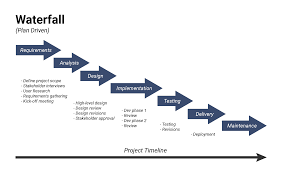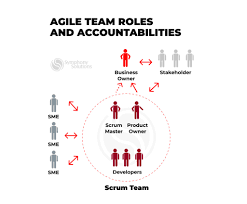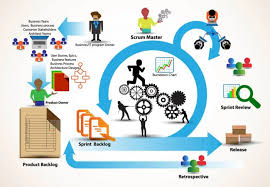The Agile Software Development Methodology
Agile software development is a methodology that emphasizes flexibility, collaboration, and customer satisfaction in the software development process. It focuses on delivering small, incremental releases and adapting to change quickly.
One of the key principles of agile development is the iterative approach to software development. Instead of working on one large release over a long period, agile teams break down the project into smaller iterations or sprints. Each sprint typically lasts 2-4 weeks and results in a potentially shippable product increment.
Another important aspect of agile methodology is the close collaboration between cross-functional teams. Developers, designers, testers, and business stakeholders work together throughout the project to ensure that the product meets customer requirements and quality standards.
Agile also promotes continuous feedback and improvement. Regular retrospectives allow teams to reflect on their processes and make adjustments for future sprints. This feedback loop helps teams learn from their experiences and continuously improve their work.
By embracing change and focusing on delivering value to customers, agile software development enables teams to respond quickly to market demands and deliver high-quality products efficiently.
Understanding Agile: 7 Common Questions About Agile Software Development Methodology
- What is agile software development methodology?
- What are the key principles of agile methodology?
- How does agile differ from traditional software development approaches?
- What are the benefits of using agile methodology in software development?
- How do agile teams manage project requirements and changes?
- What role does collaboration play in agile software development?
- How can organizations transition to agile methodology from their current practices?
What is agile software development methodology?
Agile software development methodology is a flexible and iterative approach to software development that emphasizes collaboration, adaptability, and customer satisfaction. It involves breaking down projects into smaller iterations or sprints, each focused on delivering a potentially shippable product increment. Agile teams work closely together, including developers, designers, testers, and business stakeholders, to ensure that the final product meets customer requirements and quality standards. By promoting continuous feedback and improvement, agile methodology allows teams to respond quickly to changes and deliver high-quality software efficiently.
What are the key principles of agile methodology?
The key principles of agile methodology revolve around flexibility, collaboration, and customer satisfaction. Agile emphasizes iterative development, where projects are broken down into smaller increments or sprints to deliver value quickly and adapt to change efficiently. Cross-functional teams work closely together throughout the project, fostering collaboration and ensuring that the product meets customer requirements. Continuous feedback and improvement are also fundamental principles of agile, with regular retrospectives enabling teams to reflect on their processes and make necessary adjustments for future iterations. By embracing these principles, agile methodology enables teams to deliver high-quality products that meet customer needs effectively.
How does agile differ from traditional software development approaches?
Agile software development methodology differs from traditional software development approaches in several key ways. Unlike traditional methods that follow a linear, sequential process, agile is iterative and incremental, allowing for flexibility and adaptation to changing requirements throughout the project. Agile emphasizes collaboration and communication among cross-functional teams, whereas traditional approaches often involve siloed departments working in isolation. Additionally, agile promotes delivering working software in short iterations, enabling quicker feedback and course correction, while traditional methods typically involve longer development cycles with a single final release. Overall, agile’s focus on customer satisfaction, continuous improvement, and responsiveness to change sets it apart from more rigid and predictive traditional software development approaches.
What are the benefits of using agile methodology in software development?
The benefits of using agile methodology in software development are numerous. Agile allows for greater flexibility and adaptability, enabling teams to respond quickly to changing requirements and market demands. By breaking down projects into smaller iterations, agile promotes incremental progress and early delivery of value to customers. Collaboration among cross-functional teams fosters better communication and alignment, leading to improved product quality and customer satisfaction. Additionally, the iterative nature of agile development allows for continuous feedback and improvement, resulting in a more efficient and effective development process overall.
How do agile teams manage project requirements and changes?
Agile teams manage project requirements and changes by prioritizing collaboration, flexibility, and adaptability. At the beginning of a project, agile teams work closely with stakeholders to define and prioritize requirements based on customer needs. These requirements are captured in a product backlog, which is a dynamic list that can be adjusted as needed throughout the project. When changes arise, agile teams embrace them as opportunities for improvement rather than obstacles. They use techniques such as user stories, sprint planning, and daily stand-up meetings to ensure that everyone is aligned on project goals and any changes can be incorporated seamlessly into the development process. By maintaining open communication and a focus on delivering value to customers, agile teams effectively manage project requirements and changes to produce successful outcomes.
What role does collaboration play in agile software development?
Collaboration plays a crucial role in agile software development methodology. It is the cornerstone of the agile approach, emphasizing the importance of teamwork and communication among cross-functional team members. In agile, collaboration ensures that developers, designers, testers, and business stakeholders work closely together throughout the project to share ideas, feedback, and knowledge. By fostering a collaborative environment, agile teams can respond quickly to changes, adapt to evolving requirements, and deliver high-quality software that meets customer needs effectively. The continuous collaboration in agile helps build trust among team members, promotes transparency, and ultimately leads to successful project outcomes.
How can organizations transition to agile methodology from their current practices?
Transitioning to agile methodology from traditional practices can be a challenging but rewarding process for organizations. It requires a shift in mindset, culture, and processes to embrace the principles of agility. To successfully transition, organizations can start by educating their teams about agile concepts and practices through training and workshops. It is crucial to involve key stakeholders early on and communicate the benefits of agile methodology to gain buy-in across the organization. Implementing small pilot projects or proof of concepts can help teams experience agile in action and build confidence in the new approach. Additionally, organizations should be prepared to adapt their structures and processes to support agile development, such as establishing cross-functional teams and implementing iterative planning and delivery cycles. Continuous feedback and improvement are essential during the transition phase to address challenges and optimize the adoption of agile practices within the organization.




